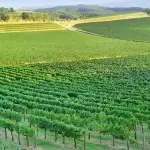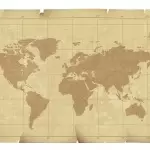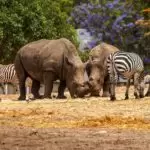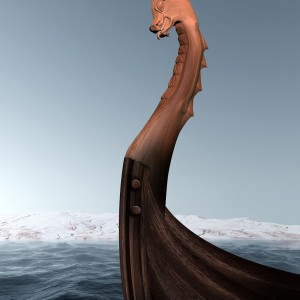
The study of the people of the past is called archaeology. The discipline has been around for several hundred years but has undergone vast change in that time. The romantic ideal of the treasure hunter searching for items of national interest is long gone. The modern archaeologist is as much a manual labourer as a historian and most digging work is not exciting - turning up little of interest most of the time. That said, there is no shortage of archaeology degrees all over the world with the highest concentrations in Europe. It is now as much an environmental science, often looking at the same sort of data that a geographer or a climatologist might look at, but often relating it to human history.
In Europe, most universities offer archaeology degrees and a bachelor's degree is usually enough for excavation work. Students will look at historical documents and environmental data as part of their undergraduate degree. Where research roles are concerned, typically a master's degree will be required but graduates will already have the tools and covered the sort of data they may be looking at. In North America, it is seen as a subset of anthropology but the theories and practices are much the same.
Everybody thinks they know something about the Vikings - they are either those invaders from the north who attacked, raped and pillaged their way around Europe in the 9th century, or they are heathens sent by God to punish the wrongdoers of Christendom, or they are a misunderstood warrior society who added so much to European culture. For most of the last 100 years or more, history has not been very kind to them, portraying them as oafish and violent though this was largely the influenced by contemporary writing such as the Anglo-Saxon Chronicle (1).
Who Were the Vikings, Really?
Between the 8th and the 10th centuries, groups of traders, warriors and settlers swept out of their Norwegian and Danish homelands looking for new lands to settle and riches to find. Put under pressure by Flemish and Frankish expansion, some of the dispossessed landowners moved into the Baltic and into Russia and westwards along the north European coast (1) (3, p3-4). There is some argument about why they did it - for a time, it was believed there were population pressures but recent evidence has suggest that this was not the case, that they sought wealth to expand their influence back home. They had no particular disdain for Christians despite popular belief - but saw easy pickings at the undefended settlements and monasteries of northern and western Europe. They made good mercenaries for hire by the kings and lords of both France and England in their internal struggles and those against their neighbours. Vikings were after all, interested largely in money to take home and their religion and society was built on warfare.
While it is true that theirs was a warrior society, it is not true that they lacked technology or culture. They were primarily traders who traded goods all over Europe, with Islamic countries and even as far away as China (2); they produced some quite remarkable objects too. They valued silver more than gold - reasons that are still not completely understood but could be as simple as mere aesthetics.
They settled lands too. In France they created Normandy (3, p13), in England they were granted the Danelaw (3, p10-11) by King Alfred; they settled in Scotland and in Ireland and the islands of the English Channel and the Irish Sea (3, p13-14). They were a seafaring people and so travelled to the Orkneys and Shetlands, to the Faroe Islands, Iceland, to Greenland and eventually to North America (3, p12) and we're only just now beginning to understand the extent of the impact these interesting people had on European genetics (4) and culture (5).
They were largely successful and became an important part of the early medieval cultural landscape. They were very successful most of the places they settled, so why did it go so wrong for them in Greenland and what can environmental data tell us about those who lived there?
Viking Greenland as an Environmental Case Study
Early Success
Located in the very north of the Atlantic Ocean, Greenland is one of the largest islands in the world. We know that Greenland was settled from the Viking colonies of Iceland around AD1000; documentary evidence places its settlement at AD985 (3, p117-118). Despite that the east coast is a cold, harsh and barren place, and the centre of the island is an enormous ice cap, in stark contrast the west coast - where all of the colonies were located - is quite different. Early arrivals may have found the island's topography remarkably similar to Norway's, and they would have felt at home in the subarctic conditions and its coastal crags would certainly have made it more appealing to the sort of lifestyle to which they were already accustomed.
We know that they hunted the coastal areas for walrus and seal (7, p159; p165), the uplands and lowlands for reindeer and local fowl (7, p159). We also know that they whaled the seas around the colonies (3, p119) and ate a lot of fish (7, p165). Today, Greenland is well known for its salmon stock and it's likely it was then too. Other fauna species include muskox, arctic hare, arctic foxes and several species of whale (6). Documentary and pollen evidence shows that the Viking colonists did not exist solely on hunting marine and land game, they of course eventually planted crops too. Being on the same latitude as Norway and Iceland, this would have naturally occurred to the colonists. To all intents and purposes, and despite the arctic conditions, the colonists would have had a comfortable existence in the early years.
Despite that visitors to Greenland found human and artefact remains in the 18th century, it wasn't until the 1990s when extensive excavations got underway that archaeology was able to learn so much more about the Greenland Vikings (9). We now know that they resided on a small fertile coastal trip to the south of the glaciers (10) and we now know this colony was in place from the end of the 10th century until the mid-14th century.
The fact that it lasted several hundred years and at its peak had a population of 5000 (9) suggests that for a long time, they were able to make it work. Yet its end was for many years one of the great mysteries in archaeology. It failed so spectacularly and so quickly that it remained a puzzle for a long time and is still debated today. What went wrong? There are many competing theories but what we do know is that the colony lived through two of the most critical climate events of the last 1500 years: The Medieval Warm Period (MWP) and the Little Ice Age (LIA). On arrival of the first ships, the former possibly lulled them into a false sense of security about the viability of the Greenland colonies, and the latter critically reduced the viability of their continued success. However, most suggest that the inflexibility of the colonists and their unwillingness to move away from the practices of their European identity meant it was doomed. Isotope studies of the ice sheets in Greenland have demonstrated vast changes on this island (16, p3-4) and periods of extreme cold for several years in the early 14th century (16, p5).
Changes to Climate and Diet
It is well documented that the North Atlantic Region underwent several periods of sudden cooling through the medieval period, the earliest of which may have begun around AD1275 (12) which would have greatly affected the Viking colonists of Greenland. Indeed, many researchers now accept that the climate fluctuations of the period greatly affected what was already borderline marginal landscape (13). Despite that there is still disagreement about precisely when the LIA started, documentary evidence shows that access to the Greenland colonies was being increasingly hampered by increased amounts of annual drifting ice (16, 4).
What they did do though, is cut down lots of trees to plant crops, to trade the wood or to send it back to Norway in tribute (14, p249-50) and ecology has shown us time and time again how problematic that is in marginal landscapes. The soil was already fragile then, and the intensive farming (for the period at least) permissible in Europe and to a certain extent in Iceland, meant that the soil of Greenland could be easily exhausted (8, p3), and it was. We also know that they established dairy and sheep farms (11) and tried to rely less and less on the hunting that some saw as “pagan” practices of the past (14, p245-7). They did however, continue to eat fish increasing the percentage of fish in their diet from 20% in the early years to 80% much later on (7, p165). However, we must be careful about making assumptions here. We know their marine diet increased and surviving bones suggest this was largely seal meat - this survives much better than any other type of marine bones.
The taboo against “pagan” practices may have come from the church or from the local nobility (some sources suggest the colonists were forbidden to trade and to learn from the Inuit tribes with whom they had previously had contact (10)), or may have been a social attitude where the colonists wished to maintain a European identity (16, p1-2). The Greenland Vikings certainly played a part in their own demise, not just through the over-farming mentioned above, but also through destroying native vegetation for farmland and cutting turf that was not as rich in minerals as they were used to (14, p248). Thanks to a heavy reliance on livestock farming (14, p254), trees and crops may have been trampled by introduced livestock in the fragile winter months; there is soil evidence from the lakes and rivers that many nutrients were simply washed away. We know this from the extensive palynology (pollen analysis) and radiocarbon dates that show a severe change in the topography and the crops that were being planted between the Viking arrival at the end of the 10th century, and the early 14th century where it all went wrong, replaced native trees on a mass scale (14, p254).
The change of lifestyle could not have come at a worse time as the LIA was underway; this used to be a matter of debate but the issue is now incontrovertible (16). The temperature dropped, meaning that the growing season was shortening, as was the period for which cattle could be left out to pasture (11). Cattle and sheep need food, which was increasingly in short supply because fertility of the land was dropping, and the human population increasing. An unwillingness and inability to adapt to the natural climate changes around them, as well as understanding the extent of the damage they were doing to themselves, meant it was only a matter of time before the colony failed (15).
Conclusion
In brief summary, we know that the Vikings were heavily reliant on hunting, fishing and whaling at the beginning of the Greenland colonial period. This happened to be at the start of the Medieval Warm Period and the climate of Greenland at the time would have been very attractive to the colonists coming from Iceland and later from Norway to whom they owed fealty. Later on, they converted to Christianity and either through taboos from the church, the nobility or simply through social attitudes of wishing to express their European identity stridently, they chose to abandon most of those practices that would have been vital to their survival. We know they grew the sort of crops they would have grown in Norway, France, England and Ireland - crops that may have been too intense for the soil. They cut and burnt the trees and farmed livestock too, particularly sheep and cows. All of this put a tremendous amount of pressure on already fragile soil. When the climate started to change, it was only a matter of time before the colony failed if they chose not to adapt. It seems the damage had been done.
A marine diet may have saved them had they been reliant on it from much earlier. As it was, it made up only 20% of their diet in the early years, but 80% in the later years. Most evidence suggests that they ate a lot of seal meat - though this could be because the bones survive better than other types of marine diet.
Sources
- http://www.fordham.edu/halsall/source/angsax-chron1.asp
- http://www.academia.edu/1514031/Vikings_in_England
- http://natmus.dk/fileadmin/user_upload/natmus/forskning/dokumenter/SILA/Projects/radiocarbon.pdf
- http://www.uio.no/studier/emner/hf/ikos/MAS2300/v05/undervisningsmateriale/Pensum/Vesteinsson%20et%20al%202002%20-%20Enduring%20Impacts%20Viking%20Settlement.doc
- http://archive.archaeology.org/online/features/greenland/
- http://archive.archaeology.org/online/features/greenland/
- http://www.sciencedaily.com/releases/2012/01/120130131509.htm
- http://cpor.org/ce/Diamond(2005)Collapse-HowSocietiesChooseFailureSuccess.pdf
- http://www.morrisville.org/pahs/classrooms/social.studies/putvain/documents/TheFateofGreenland.doc
- http://www.york.ac.uk/teaching/history/pjpg/Greenland.pdf
- Guide to Parasitology - November 19, 2018
- Deserts as Ecosystems and Why They Need Protecting - November 19, 2018
- Conservation: History and Future - September 14, 2018
Related Articles
Featured Article
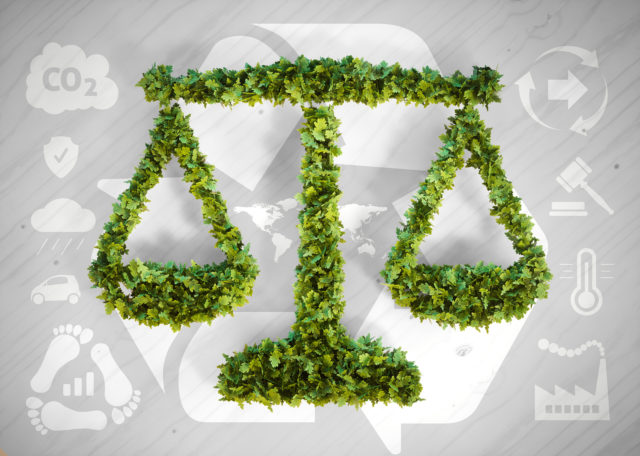
Environmental Law: Government and Public Policy Towards the Environment


